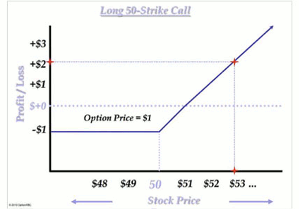When an equity option you purchased winds up in-the-money at expiration, resist the temptation to celebrate right away until you’ve completed two more steps, cautions option expert Greg Loehr of OptionABC.com.
At the beginning of just about every option basics course, we are presented with a risk profile of a long call option. It looks very much like the diagram below:
This is the profile of the 50-strike call for which we paid $1.00. I have highlighted the point on the expiration graph where the stock has settled at $53 per share. At this point, the graph shows that we end up with a profit of $2.00.
The reason is simple. We bought the 50-strike call for $1.00. This gives us the right to buy stock for $50. However, the stock settles at $53. Therefore, since the stock is at $53, we could sell it there. Coupled with the fact that we have the right to buy stock at $50 due to owning the 50 call, we can make $3.00 from that set of transactions. Of course, we have to remember that we paid $1.00 to enter the trade in the first place, so we have to discount that from our earlier $3.00 profit. That leaves us with a net $2.00 of profit as shown by the graph.
That part is simple enough. The problem lies in the assumption by the average retail trader that this profit comes to us automatically. It does NOT.
It is extremely important that retail traders understand how the settlement process works when an option expires in-the-money. Even if the option settles in-the-money by more than the premium paid for it, there is no guarantee that the retail trader will end up with the profit on the graph. The reason is that while the exercise process is fairly automatic, the rest of the necessary transactions are not. Let’s explain:
Suppose that you bought the 50 call for $1.00 some time prior to expiration and you let it expire. As luck would have it, the stock settles at $53 per share. You look at your trusty graph and see that you have made $2.00 net profit on the trade. You smile and go back to sleep.
The Reality
Here is what really happened. At expiration, your stock settled at $53 per share. Your long 50 call was in-the-money by $3. It was automatically exercised for you because ANY option that is at least one cent in-the-money at expiration is exercised.
Therefore, if you have done nothing else, come Monday morning, what you will see is that you are now the proud owner of long stock at a purchase price of $50 per share.
In order for you to make $3.00 (and hence net $2.00 profit) on the trade, you MUST sell the stock on Monday at $53 per share or greater!
Of course, stocks do not simply sit still on any given day for our convenience. It may turn out that on Monday morning the stock opens lower than $53 and we do not make our expected profit. Then again, we could get completely lucky and have the stock open higher and make more than what we would have profited had we been more responsible.
The point is that we subject ourselves to random fluctuations, and while we may have been willing to do that with a long call option where our risk was limited to the $1.00 premium we paid, on Monday morning, our long stock position has a much different looking risk profile with greater downside exposure.
So to conclude, if you do not want to expose yourself to the random stock fluctuations that will in all likelihood occur from Friday’s close to Monday’s open, exit the trade prior to expiration or if you are allowed to, pre-sell the stock on Friday to lock in the profit.
By Greg Loehr, Owner, OptionABC.com






















